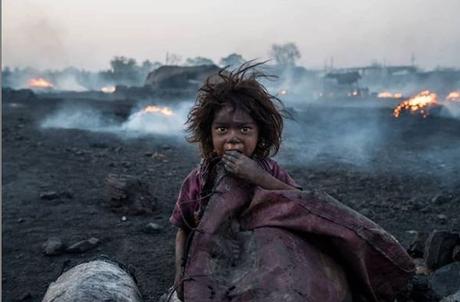
The largest Coalfield of India, Jharia located in the state of Jharkhand has deposits of 19.4 billion tonnes of coking coal. It is India's most important storehouse of prime coking coal having 23 large underground and 9 large open cast mines.
Coke is used in the blast furnaces and is the main support for the Iron and Steel industry. Also, it was a prime source of energy for Indian Railways until the early 90s. Not to forget that about 60 percent of India's power supply is generated from coal.
So, whenever we say Jharia, we can only imagine how much contribution it has made in the development of India. But what we do not know is about the villages, which is burning for over 100 years.
Instagram Handle: thevikashsingh1
Jharia coal mine located in the Dhanbad district of Jharkhand is spread across an area of 450 square kilometers. The area has 70 small tribal villages, which are located in the edge of deep open-pit coal mine of Jharia which continues to burn underneath at 67 different areas. In many places, a few meters below the earth's surface, the temperature is as high as 700 degrees centigrade.
The Burning Jharia
The first fire was witnessed in the year 1916 and according to reports, the fire was not caused due to any natural reasons but due to over-exploitation by the private owners of the mines. Coal fires can be caused by lightning, and forest fires, but here the case was different.
However, the coal mines in India was nationalized in the year 1971, when 70 such fires occurred in the underground mines of Jharia. It also led to the incorporation of Bharat Coking Coal Limited (BCCL) in the year 1972.
BCCL was established to operate coking coal mines operating in the Jharia as well as Raniganj Coalfield, which was taken over by the Govt. of India to ensure the planned development of the scarce coking coal resources. It is a subsidiary of Coal India Ltd, a Public Sector Undertaking, engaged in mining of coal and allied activities.
But despite the measures taken by the Government, the fire is still burning underneath Jharia. Over the years it has only worsened, resulting in one of the world's oldest and most widespread mine fires today.
The reason behind this is till today illegal mining activities take place in Jharia. It is the only mine where you get high-quality coking coal and to be honest, there is coal everywhere around the region. Therefore, illegal mining activities take place without following any procedures of safe mining.
Any human effort to stop the fires has resulted in a failure. It gets worsens on a rainy day when the thick smoke from underground spreads over the area, and as the skies clear, large columns of underground fires become visible.
More than 1,30,000 families are settled in the area who are exposed to underground fires and the smoke. Regular incidents have led to the degradation of soil, air, and water quality overtimes.
Not only this but the people living in the region suffer from respiratory diseases like tuberculosis and bronchitis as hazardous gases such as sulfur dioxide, carbon monoxide, and arsenic are released into the atmosphere in the form of smoke. Several locals also complain of persistent coughs, headaches, and pain in the chest. Accidents and untimely deaths are not uncommon in the villages present in the region.
The fire has also caused a major impact on the occupation of the people residing in the area. Due to the toxic soil, farming is no longer an option here, and therefore, the people have no choice but to work in the coal mines as daily wage laborers, making themselves more exposed to the threat, or as a house help. The majority of the children are child laborers loading coals for less than INR 200 per day.
In the year 2008, BCCL began a program to relocate almost 53,400 families living in the fire-affected areas by 2021 and had identified 595 sites for rehabilitation out of which 11 sites were under the jurisdiction of West Bengal. By the end of 2019, they were able to relocate only a few families.
Meanwhile, many tribal people have started settling in nearby places. Some are shifting in flats built by the Jharia Rehabilitation and Development Authority (JRDA) away from the fire-prone areas, but to be true, the process of rehabilitation is slow.
As the 2021 deadlines near, the residents across the Jharia mines remain trapped between an uncertain future and hellfire.
Frequently Asked Questions
What is Jharia famous for?
Where is Jharia located?
Why Jharia is burning?
cover Picture Credit: Instagram Handle: irimages

